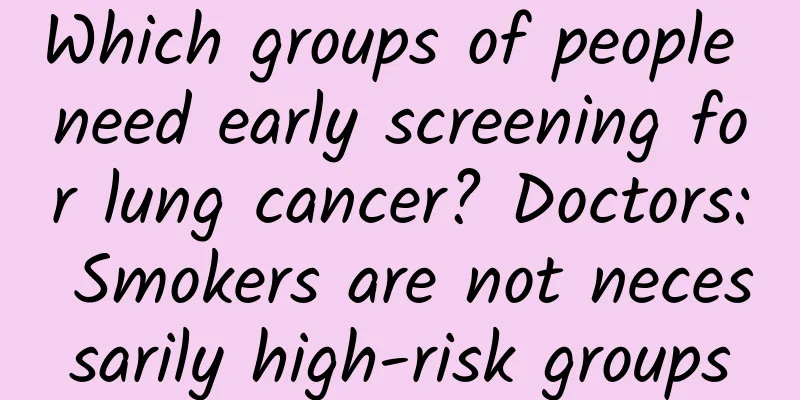Which groups of people need early screening for lung cancer? Doctors: Smokers are not necessarily high-risk groups

|
Lung cancer is the world's most common cancer. According to the 2020 Global Cancer Report, the number of lung cancer cases and deaths are both ranked first. As the "leader" in the cancer world, 80% of lung cancers are discovered in the late stage, which means that the best time for surgery has been missed. If lung cancer is discovered and removed in the early stage, it will not only not affect the survival cycle, but can basically achieve clinical cure. So which groups of people need early screening for lung cancer? Let's talk about it today. What are the high-risk factors for lung cancer? As the most common tumor in the world, many factors are closely related to the occurrence of lung cancer. The most common ones are the following First: Smoking and secondhand smoke The relationship between smoking and lung cancer has been confirmed, especially squamous cell carcinoma of the lung is closely related to smoking. Cigarettes contain dozens of carcinogens, which are inhaled into the respiratory tract with the smoke and cause continuous damage to the lungs. Therefore, the World Cancer Organization has classified cigarettes as a Class 1 carcinogen. In addition to smoking, the harm of secondhand smoke has gradually received people's attention in recent years. Studies have found that long-term exposure to secondhand smoke is even more harmful than smoking alone, so staying away from cigarettes and secondhand smoke is equally important. Second: Smoke and fumes in daily life Although smoking is closely related to lung cancer, the incidence of lung cancer in non-smoking women in Asia has been increasing year by year. This is related to smoke and cooking fumes in daily life. For example, incomplete combustion of fuel will produce benzopyrene, polycyclic aromatic hydrocarbons and other carcinogens. Compared with Europeans and Americans, Chinese people prefer to eat food stir-fried over high heat. The high-temperature fumes will produce a variety of carcinogens, so this is also the reason why the incidence of lung cancer in non-smoking patients is increasing year by year. Third: Air pollution When it comes to the impact of air pollution on lung cancer, the most famous incident is the London Fog. At the end of 1952, the upper floors of London were shrouded in smog, accompanied by the smell of rotten eggs. The smog contained a large amount of benzopyrene, benzene, some metals, particulate matter, ozone, etc. The high incidence of lung cancer in London at that time was closely related to the environment. As the environment in London improved, the incidence of lung cancer also gradually decreased. Fourth: Occupational exposure Some people call lung cancer occupational cancer because about 10% of patients develop lung cancer due to long-term exposure to carcinogens in their special occupations. Exposure to aluminum products, arsenic, asbestos, vinyl chloride and other substances will significantly increase the incidence of lung cancer. Fifth: Family history of lung cancer In clinical work, we often encounter cases where a father and his children suffer from lung cancer at the same time, or four brothers in a family each suffer from lung cancer. This is the familial clustering of lung cancer. At present, familial clustering may be closely related to genetic factors or eating habits. Who needs early screening for lung cancer? The clinical criteria for lung cancer are often based on the National Comprehensive Cancer Network (NCCN) guidelines. The NCCN 2020 version stipulates that for high-risk patients with lung cancer, regular low-dose spiral CT of the chest is recommended. The high-risk groups for lung cancer include: 1.55-77 years old; smoking history of 30 packs/year or more; has a history of smoking but quit smoking less than 15 years ago. 2. 50 years old or above; smoking history of 20 packs/year or more; at least one high-risk factor (excluding secondhand smoke). The main high-risk factors are: smoking (including secondhand smoke), exposure to occupational carcinogens (arsenic, chromium, asbestos, nickel, cadmium, beryllium, silica, diesel exhaust, kerosene fume, etc.), exposure to radon, previous history of malignant tumors (such as lung cancer, lymphoma, smoking-related malignant tumors such as bladder cancer and head and neck tumors, etc.), family history of lung cancer, history of lung-related diseases (chronic obstructive pulmonary disease, pulmonary fibrosis), and hormone replacement therapy (female). The NCCN guidelines do not recommend early cancer screening for other people. In other words, although smoking is a risk factor for lung cancer, people who are not old enough to smoke are not considered to be at high risk for lung cancer. However, there are some differences between the physiques of Chinese and foreigners. According to the NCCN guidelines, my country has its own expert consensus on the diagnosis and treatment of lung nodules. The expert consensus recommends regular screening for the following groups: Unlike the 50-year-old age required by the NCCN guidelines, considering the younger age of lung cancer, my country's guidelines have moved the age of 50 to 40 years. In addition, my country's guidelines recommend that people who have smoked ≥ 20 pack-years (or 400 cigarettes a year) or have ever smoked ≥ 20 pack-years (or 400 cigarettes a year) quit smoking within 24 hours. |
>>: What plants and animals live in deserts? What causes tropical desert climate?
Recommend
Treatment of spinal pain after cesarean section
Many of us who have had caesarean sections may be...
What should I do if I feel nauseous and vomit during breastfeeding?
Nausea is a term in traditional Chinese medicine....
What is the cause of clear water coming out of the nipple?
It is normal for women to squeeze out clear water...
What to do if your menstrual period is black
Menstruation is an important indicator of women&#...
What is the best way to change the color of the wheel hub?
The wheels of cars are generally made of aluminum...
Can cataracts be cured with drops of medicine? Do it when you are "fully prepared"? Avoid these misunderstandings as soon as possible~
“Wait until the cataract is fully mature before d...
Eating the root of the moon makes it easier to get pregnant
The root of Yueyuehong is the root of rose, which...
Will ovulation occur one day after menstruation ends?
The ovulation period generally varies from person...
What should mothers do if their gums are swollen and painful during breastfeeding?
Spring is the season when people are most likely ...
What causes pulling pain in the left lower abdomen of pregnant women?
Pregnant women need special care for their bodies...
Does exercise have any effect after lung nodule surgery?
"Does exercise have any impact after lung no...
What causes ovarian tumor recurrence?
Patients need to be vigilant about the recurrence...
I had sex on the day after egg retrieval.
Many women may have difficulty getting pregnant, ...
Why does a woman have a stomachache when she is pregnant?
As the saying goes, the first three months of pre...
The reason why spots appear on the face during pregnancy
Expectant mothers often encounter spots on their ...









